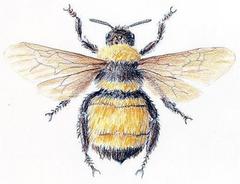|
 Bombus pennsylvanicus, Bumble Bee Illustration by Nancy Lowe, 2002 |
|
Introduction/Justification Pollinators are thought to be in significant decline throughout North America. The 4000 species of bees found in the United States are the primary pollinators of plants, both native and invasive, as well as many agricultural crops. In response to this situation the Department of Interior and other groups have joined together to form the North American Pollinator Protection Campaign (http://www.nappc.org/). Unfortunately, within North American there exist no replicable historic data on pollinator populations that permit statistical comparisons. Consequently, we have no idea if pollinators have declined in ways similar to those seen in European countries. Groups at Interior (Patuxent Wildlife Research Center), USDA (Logan Native Bee Laboratory), and various academic groups have completed much of the work necessary to best survey and monitor native bees (http://online.sfsu.edu/~beeplot) and are beginning to advocate the start of surveys in National Parks, Refuges, states, and other geographic areas. Unfortunately that cannot occur until an important and limiting factor is rectified. The lack of current, accurate, and usable identification keys for most native bee species. Fortunately, we have pulled together a group of scientists who are helping us consolidate 50 years of scattered taxonomic updates on these species along with a wealth of unpublished information. In turn, we are placing that information on our web site using the new, powerful online guide software created by Discover Life (http://www.discoverlife.org). Lack of such identification guides currently limits the amount and quality of both the research and monitoring aspects of native bee study. The USGS' and the scientific community's need for such web-based bee keys mates well with the NBII's role in promoting and disseminating such information. Once this information is available then we can begin truly supporting the collection of good scientific information on bees and other pollinators in the United States. Until these guides come available we are blocked from moving forward. Proposed Project
We wish to finish the creation of the online keys to all of the 66 genera of bees found in the East. We will have created pilot keys for about 20 of those genera. Most of these keys ultimately will have both the words and the illustrations that go along with them. However, in this proposal we are asking only for enough support to do the difficult work of compiling, word-smithing, and testing the text component of an additional 20 guides. We are looking elsewhere for support for the remaining keys and the illustrations.
Description of Proposed Project The beauty of these keys is that not only do they speed up identification because of their structure, but they can be immediately updated if name changes or information about better ways to identify them occur. These keys also create most of the framework for constructing keys for the remaining bees of the western states as the characters have already been chosen and the software developed; what remains is the simpler task of scoring the specimens.
List of participating organization(s), names of personnel, and their role in supporting the project
Progress to Date
Major Deliverables
Timeline Budget (in addition to previously-proposed work for FY05)
|